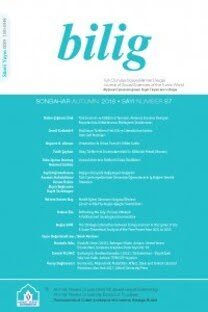Osmanlı Devletinde Deliliğin Tarihi: Toptaşı Örneği
The History of Madness in the Ottoman State: Toptaşı Example
___
Başbakanlık Osmanlı Arşivi (BOA)DH. EUM. THR Dosya No :63 Vesika No :28 :100 :6 :58 :63 DH. İD Dosya No :55 Vesika No :79, 81, 91, 92 DH. MKT Dosya No :173 Gömlek No :31 :2279 :8 :2320 :37 :1504 :2 9 :1883 :8 :2015 :118 DH. UMVM Dosya No :80 Vesika No :59 :95 :9 :113 :57 ZB Dosya No :451 Gömlek No :76, 129 :312 :47 :404 :42 :610 :31 :366 :74 :393 :109 :441 :11 :68 :108 :98 :22 Y.EE 132/31. o Bayülkem, Faruk (2002). Türkiye'de Psikiyatri, Nöroloji ve Nöroşirurji'nin Tarihi Gelişimi. İstanbul: Roche.
Ergin, Osman (1940). Tıp Mektepleri, Enstitüleri ve Cemiyetleri. İstanbul: İstanbul Üniversitesi Tıp Tarihi Enstitüsü.
Erkoç, Şahap ve Yazıcı, Olcay (Ed.) (2006). Mazhar Osman ve Dönemi mecnunla- rı, mekanları, dostları. Yy: Argos İletişim Hizmetleri.
Kazancıgil, Aykut (1991). Binbaşı Elhac Rıza Tahsin'in, Tıp Fakültesi Tarihçesi (Mir'ât-ı Mekteb-i Tıbbiye) İstanbul: Özel Yay.
Koptagel-İlal, Günsel (1981). "Son 100 Yılda Türkiye'de Genel Çizgileriyle Psiki- yatri ve Psikosomatik Hekimliğin Gelişimi". Cerrahpaşa Tıp Fakültesi Der- gisi XII (Temmuz). 355-372.
Sarı, Nil (1992). "Toptaşı Nûrbânû Valide Sultan Darüşşifası". I. Türk Tıp Tarihi Kongresi-Bildiriler. Ankara: Türk Tarih Kurumu Yay. 169-176.
Taşkıran, N. (1972). "Türkiye Hizmetinde Büyük Bir Hekim: Süleymaniye Bîmarhânesi'nin son, Toptaşı'nın ilk Başhekimi, Louis Mongeri". Haseki Tıp Bülteni XI. 1-18.
Tez, İlhami (1965). Mazhar Osman. Yy: Burhaneddin Erenler Matbaası.
Uzman, Mazhar Osman. (1933). Sıhhat Almanakı Cumhuriyetin onuncu senesini kutlarken Hekimlerimizin halkımıza armağanı. İstanbul: Kader Matbaası.
Uzman, Mazhar Osman (1933). Sıhhat Almanakı. İstanbul: Kader Matbaası.
Ünver, A. Süheyl (1959). "Türkiye'de Psikiyatri Tarihi Üzerine". İstanbul Üniver-sitesi Tıp Fakültesi Mecmuası XXII (4): 1198-1207.
Yıldırım, Nuran (1994). "Toptaşı Bîmarhânesi". Dünden Bugüne İstanbul Ansik- lopedisi. C. VII. İstanbul: Kültür Bakanlığı ve Tarih Vakfı Yay. 295.
- ISSN: 1301-0549
- Yayın Aralığı: 4
- Başlangıç: 1996
- Yayıncı: Ahmet Yesevi Üniversitesi Mütevelli Heyet Başkanlığı
Başlangıcından Günümüze Arap Milliyetçiliği. Ankara: Grafiker Yayınları
Osmanlı Devletinde Deliliğin Tarihi: Toptaşı Örneği
Kırsal Alevî Kültüründe Çevre, Mekân ve İnsan Etkileşimi - İki Köy Örneği
Selection of Subjunctors in Turkic Non-Finite Complement Clauses
Türk Dillerinde Kipsellik ve Kipselliğin Anlambilimsel Haritası
Türk İşaret Dili'nde Sınıflandırıcılar Üzerine Bir Çalışma
An Evaluation of the International Children's Books about Turkey and Turks
Azerbaycan'da Okutulan Tarih Ders Kitaplarında Stalin ve Uygulamalarına Yaklaşım
